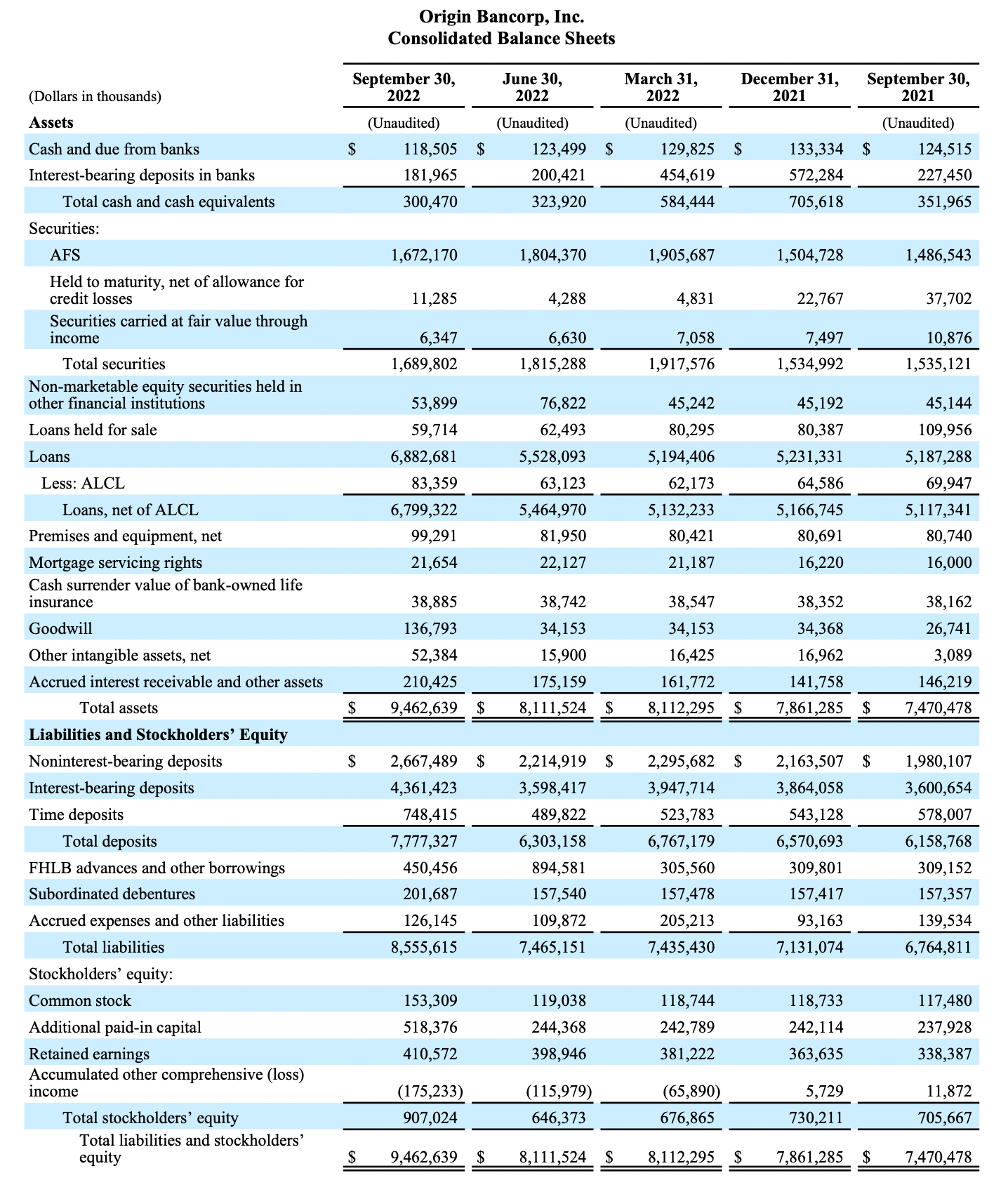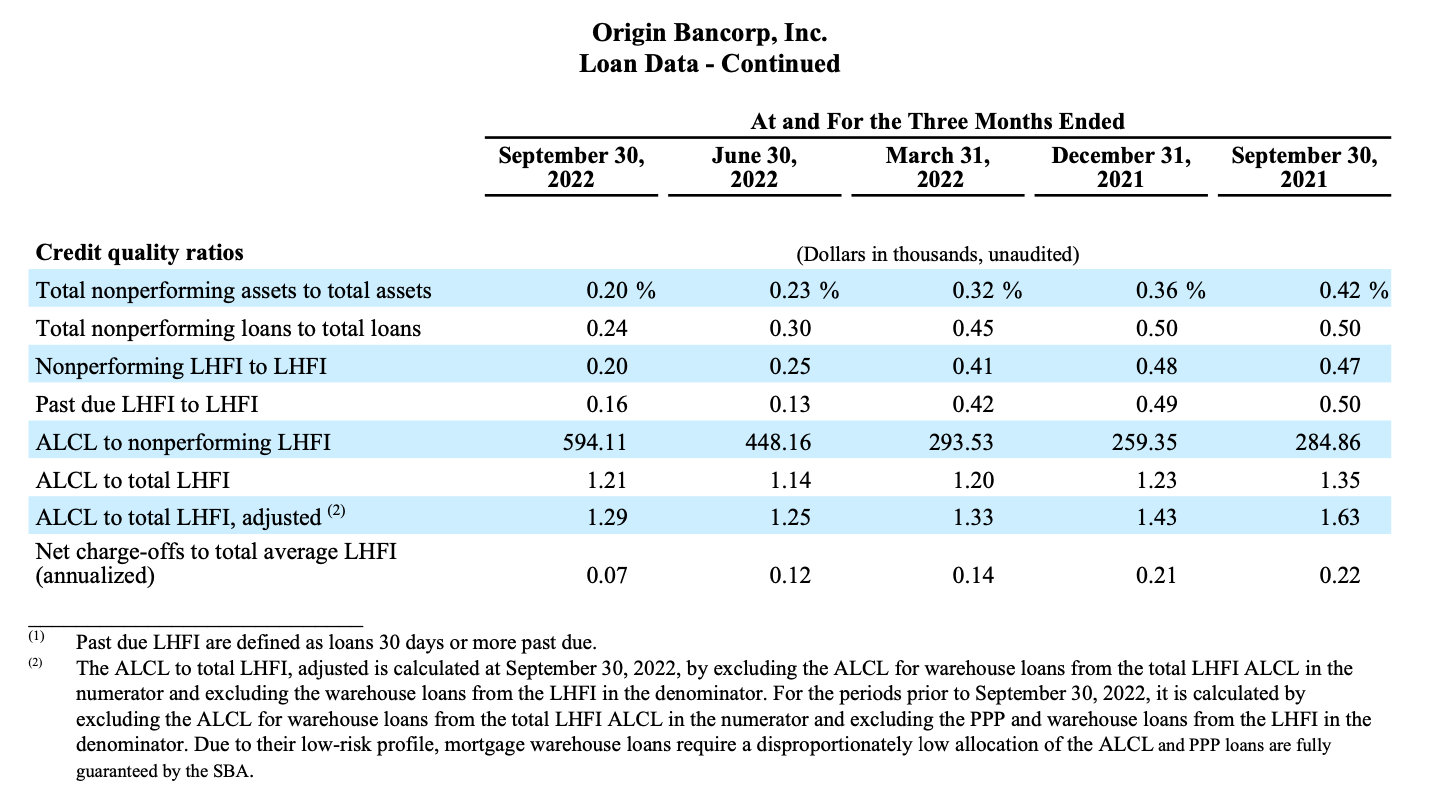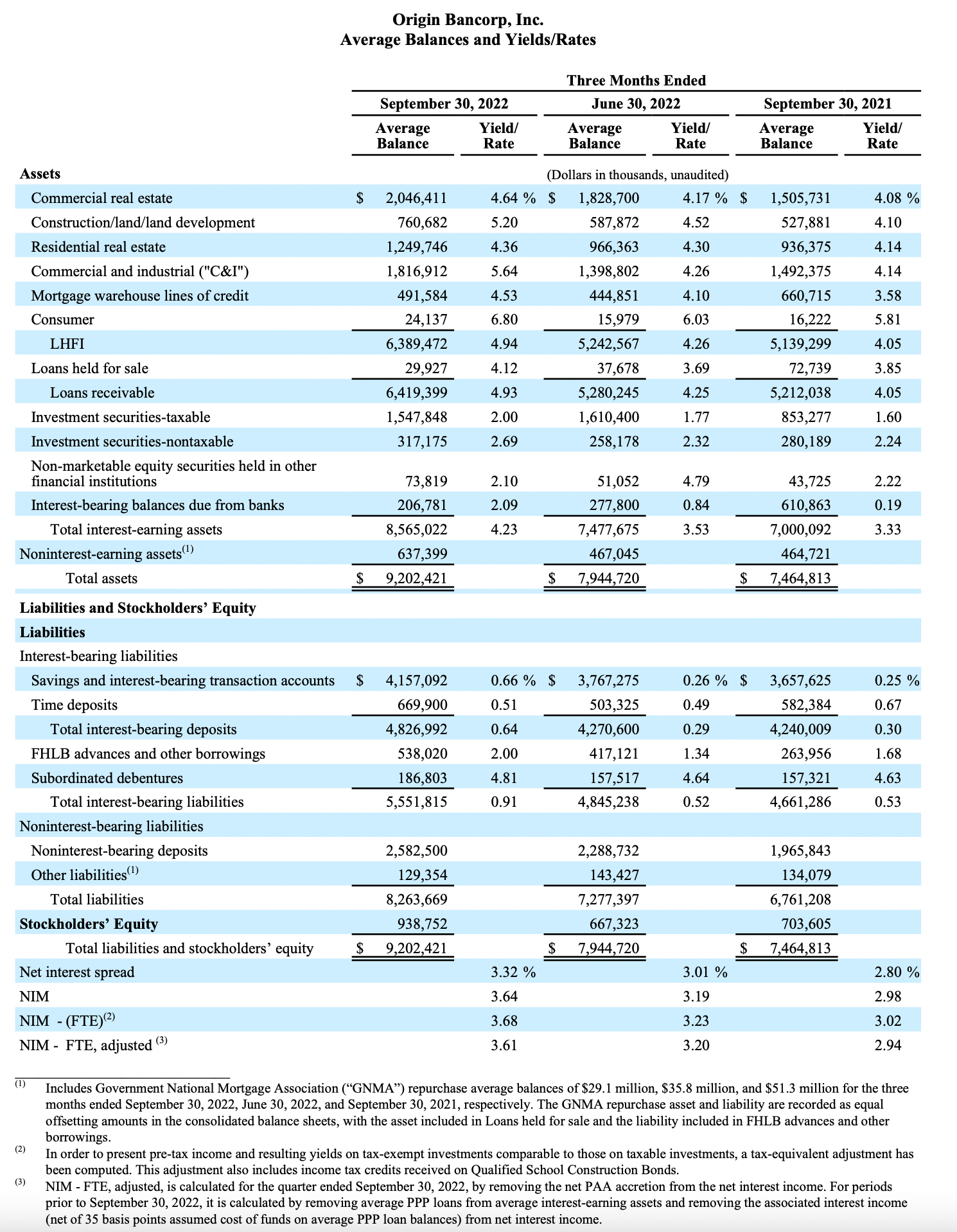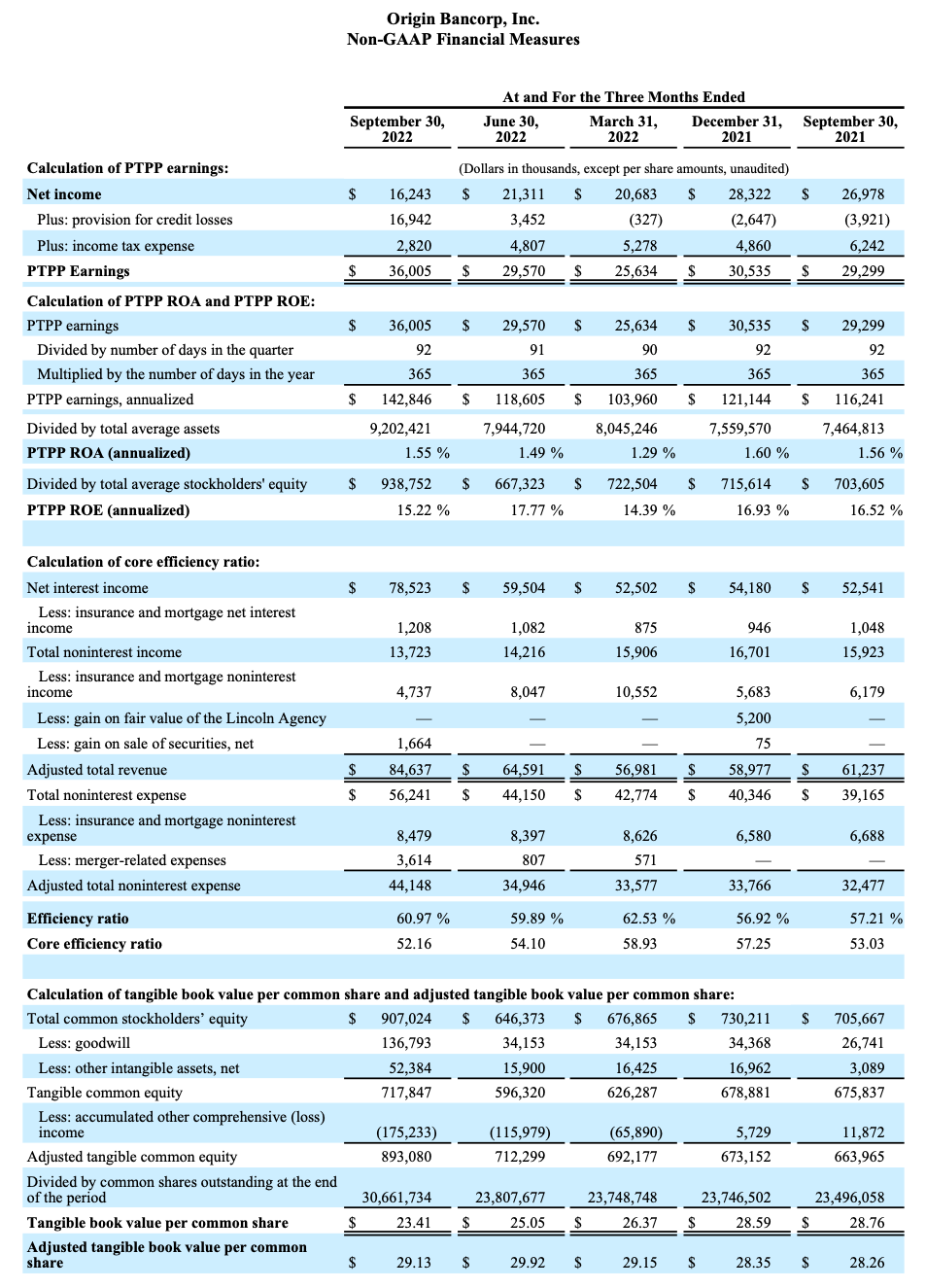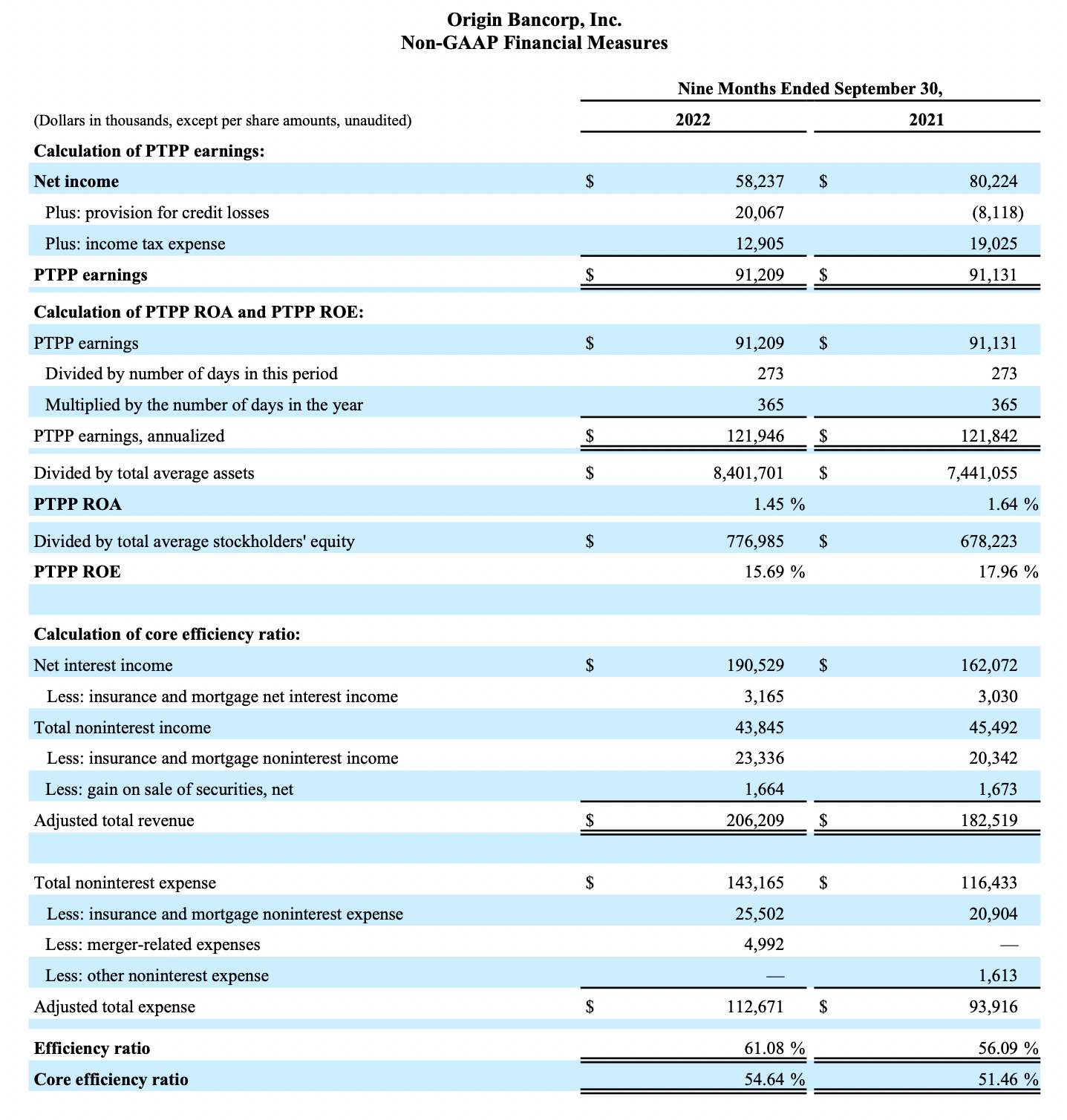Latest News
ORIGIN BANCORP, INC. REPORTS EARNINGS FOR THIRD QUARTER 2022
Origin Bancorp, Inc. (Nasdaq: OBNK) (“Origin” or the “Company”), the holding company for Origin Bank (the “Bank”), today announced net income of $16.2 million, or $0.57 diluted earnings per share for the quarter ended September 30, 2022, compared to $21.3 million, or $0.90 diluted earnings per share, for the quarter ended June 30, 2022, and compared to net income of $27.0 million, or $1.14 diluted earnings per share for the quarter ended September 30, 2021. Adjusted net income(1) for the quarter ended September 30, 2022, was $31.1 million, or $1.09 adjusted diluted earnings per share(1). Pre-tax, pre-provision net income ("PTPP")(1) was $36.0 million.
"This was a significant and exciting quarter for Origin as we showed strong core profitability and completed the merger with BT Holdings,” said Drake Mills, chairman, president and CEO of Origin Bancorp, Inc. “Origin now has meaningful expansion across the I-20 corridor in East Texas and adds impressive depth in Dallas and Fort Worth.”
(1) Adjusted net income, adjusted diluted earnings per share and PTPP are non-GAAP financial measures, please see the last few pages of this document for a reconciliation of these alternative financial measures to their comparable GAAP measures.
Third Quarter Financial Highlights
• On August 1, 2022, the Company completed its previously announced merger with BT Holdings, Inc., (“BTH”). As a result of the merger with BTH, the Company recorded a $14.9 million provision expense for loan credit losses for the Current Expected Credit Loss ("CECL") requirement on non-Purchased Credit Deteriorated ("PCD") loans, along with a $5.5 million allowance for loan credit losses on PCD loans. In total, the Company incurred $18.5 million in merger-related expenses during the quarter ended September 30, 2022, which includes the $14.9 million provision expense for loan credit losses.
• The Company's annualized returns on average assets ("ROA") and average equity ("ROE") were 0.70% and 6.86%, respectively, for the quarter ended September 30, 2022. Additionally, the Company's annualized adjusted returns on average assets ("Adjusted ROA") and adjusted return on average equity ("Adjusted ROE") were 1.34% and 13.14%, respectively, for the quarter ended September 30, 2022.
• Net interest income for the quarter ended September 30, 2022, was $78.5 million, reflecting a $19.0 million, or 32.0% increase, compared to the linked quarter, and a $26.0 million, or 49.5% increase, compared to the prior year quarter.
• The fully tax-equivalent net interest margin (“NIM”) was 3.68% for the quarter ended September 30, 2022, reflecting a 45 basis point increase from the linked quarter and a 66 basis point increase from the quarter ended September 30, 2021. The fully tax-equivalent NIM, excluding the net purchase accounting accretion (“PAA”) from the net interest income for the quarter ended September 30, 2022, was 3.61%.
• Total loans held for investment (“LHFI”) at September 30, 2022, were $6.88 billion. Adjusting for the impact of the BTH merger, and excluding mortgage warehouse lines of credit, loan growth during the quarter was $215.3 million, or 3.5%.
• Provision for credit losses was a net expense of $16.9 million for the quarter ended September 30, 2022, compared to a net expense of $3.5 million and a net benefit of $3.9 million for the linked quarter and the quarter ended September 30, 2021, respectively. The increase was primarily due to the merger with BTH, which required a Day 1 CECL loan provision of $14.9 million.
• The allowance for loan credit losses ("ALCL") to LHFI was 1.21% at September 30, 2022, compared to 1.14% at June 30, 2022. The ALCL to LHFI, adjusted(2) was 1.29% at September 30, 2022, compared to 1.25% at June 30, 2022. 1
• Total nonperforming LHFI to total LHFI was 0.20% at September 30, 2022, compared to 0.25% at June 30, 2022, and 0.47% at September 30, 2021, reflecting a 20.0% and 57.4% decrease in the ratio when compared to the linked quarter and prior year quarter, respectively. The ALCL to nonperforming LHFI was 594.1% at September 30, 2022, compared to 448.2% and 284.9% at the linked quarter and prior year quarter, respectively.
(2) The ALCL to total LHFI, adjusted, is calculated at September 30, 2022, by excluding the ALCL for warehouse loans from the total LHFI ALCL in the numerator and excluding the warehouse loans from the LHFI in the denominator. For the periods prior to September 30, 2022, it is calculated by excluding the ALCL for warehouse loans from the total LHFI ALCL in the numerator and excluding the PPP and warehouse loans from the LHFI in the denominator. Due to their low-risk profile, mortgage warehouse loans require a disproportionately low allocation of the ALCL and PPP loans are fully guaranteed by the Small Business Administration ("SBA").
Results of Operations for the Three Months Ended September 30, 2022
Net Interest Income and Net Interest Margin
Net interest income for the quarter ended September 30, 2022, was $78.5 million, an increase of $19.0 million, or 32.0%, compared to the linked quarter. Purchase accounting accretion on acquired loans was $1.2 million during the current quarter, with remaining purchase accounting net loan discounts totaling $3.9 million at September 30, 2022. Net purchase accounting accretion income on deposits and sub-debt totaled $228,000, bringing the total impact from purchase accounting treatment on net interest income to $1.4 million for the three months ended September 30, 2022. Excluding the net purchase accounting accretion, the increase in net interest income was almost equally due to increases in average interest-earning assets and increases in market interest rates, partially offset by higher interest expense primarily due to rate increases on average savings and interest-bearing deposit balances and borrowings, as explained further in the paragraph below.
The table below presents the estimated loan and deposit accretion and sub-debt amortization schedule resulting from the BTH merger purchase accounting adjustments for the periods shown.

The increase in net interest income for the three-month period ended September 30, 2022, was the result of a $25.4 million increase in total interest income partially offset by a $6.4 million increase in interest expense. Increases in market interest rates drove a $13.6 million increase in total interest income, while increases in average interest-earning assets drove an $11.8 million increase in total interest income. The increase in interest expense was primarily due to market rate increases, which drove a $4.2 million increase in interest expense on deposits and a $1.0 million increase in interest expense on FHLB advances and subordinated debt.
The Federal Reserve Board sets various benchmark rates, including the Federal Funds rate, and thereby influences the general market rates of interest, including the loan and deposit rates offered by financial institutions. In early 2020, the Federal Reserve lowered the target rate range to 0.00% to 0.25%. These rates remained in effect throughout all of 2021. On March 17, 2022, the target rate range was increased to 0.25% to 0.50%, then subsequently increased four more times during 2022, with the most recent and current Federal Funds target rate range being set at September 21, 2022, to 3.00% to 3.25%. At September 30, 2022, the Federal Funds target rate range had increased 300 basis points on a year-to-date basis. Increases in market interest rates contributed $11.6 million to the total increase in interest income earned on total LHFI, while market interest rates increased our total deposit interest expense by $4.2 million during the current quarter compared to the linked quarter.
The yield on LHFI was 4.94% and 4.26% for the three months ended September 30, 2022, and June 30, 2022, respectively, and average LHFI balances increased to $6.39 billion for the quarter ended September 30, 2022, compared to $5.24 billion for the linked quarter. The yield on total investment securities was 2.12% for the three months ended September 30, 2022, compared to 1.85% for the linked quarter. Additionally, the rate on interest-bearing deposits increased to 0.64% for the quarter ended September 30, 2022, compared to 0.29% for the quarter ended June 30, 2022, and average interest-bearing deposit balances increased to $4.83 billion from $4.27 billion for the linked quarter. Average balances of subordinated debentures also increased to $186.8 million for the quarter ended September 30, 2022, compared to $157.5 million for the linked quarter due to subordinated indebtedness assumed in the merger, and reflected a rate of 4.81% for the current quarter compared to 4.64% for the linked quarter.
The fully tax-equivalent NIM was 3.68% for the quarter ended September 30, 2022, a 45 basis point increase and a 66 basis point increase compared to the linked quarter and the prior year quarter, respectively. The yield earned on interest-earning assets for the quarter ended September 30, 2022, was 4.23%, an increase of 70 basis points and an increase of 90 basis points compared to the linked quarter and the prior year quarter, respectively. The rate paid on total deposits for the quarter ended September 30, 2022, was 0.41%, representing a 22 basis point increase from the linked quarter and a 20 basis point increase compared to the prior year quarter. The rate paid on subordinated debentures also increased to 4.81%, reflecting a 17 and an 18 basis point increase compared to the linked quarter and prior year quarter, respectively. The net increase in accretion income due to the BTH merger increased the fully tax-equivalent NIM by approximately seven basis points during the current quarter.
Credit Quality
The table below includes key credit quality information:
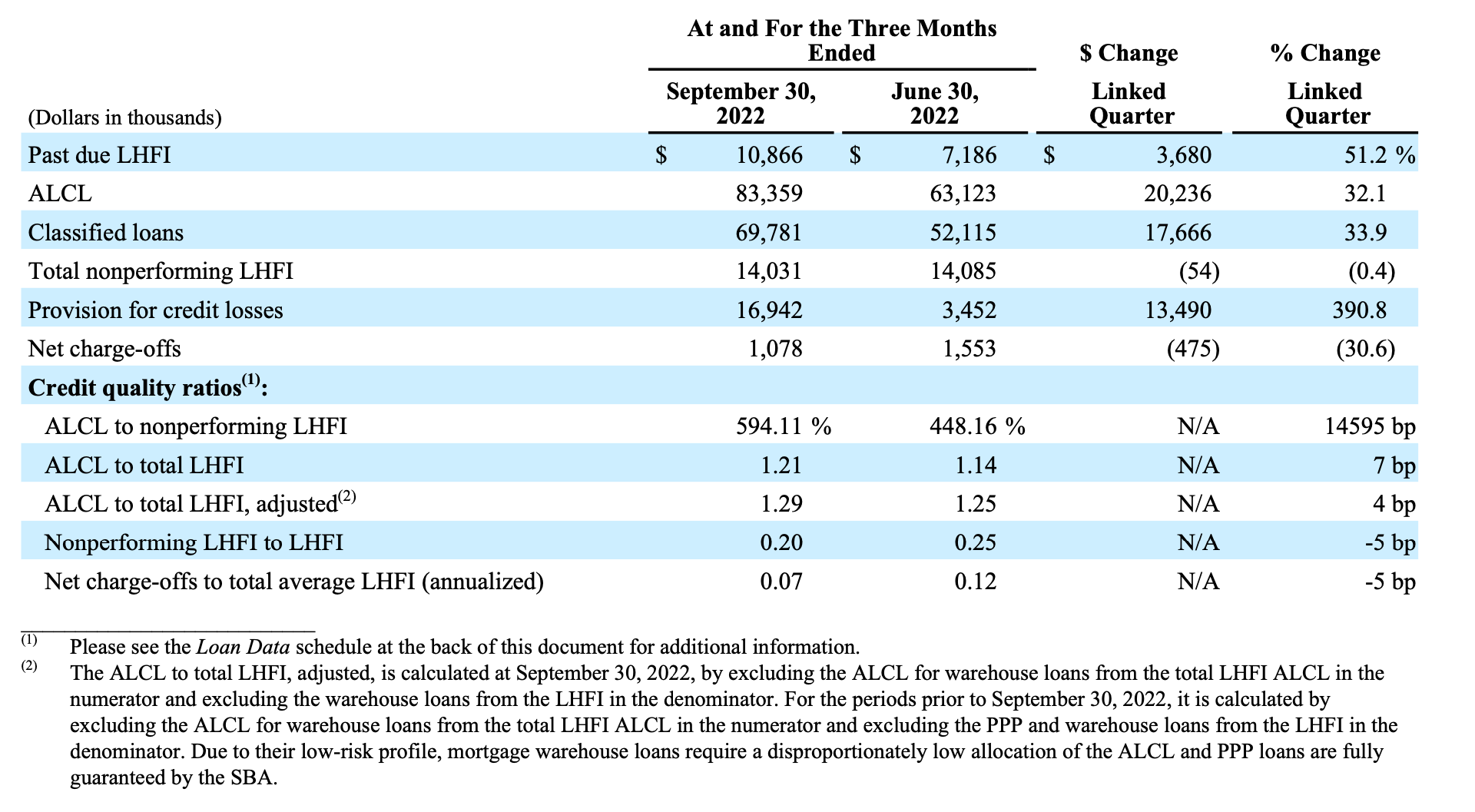 The Company recorded a credit loss provision of $16.9 million during the quarter ended September 30, 2022, compared to a credit loss provision of $3.5 million recorded during the linked quarter. The increase is primarily due to the merger with BTH, completed on August 1, 2022, which required a Day 1 CECL loan provision of $14.9 million. The remaining $2.1 million provision for credit losses in excess of the loan credit loss provision recorded in conjunction with the BTH merger was primarily due to a $1.2 million provision expense for off-balance sheet items due to an increase in unfunded loan commitments unrelated to those acquired in the BTH merger.
The Company recorded a credit loss provision of $16.9 million during the quarter ended September 30, 2022, compared to a credit loss provision of $3.5 million recorded during the linked quarter. The increase is primarily due to the merger with BTH, completed on August 1, 2022, which required a Day 1 CECL loan provision of $14.9 million. The remaining $2.1 million provision for credit losses in excess of the loan credit loss provision recorded in conjunction with the BTH merger was primarily due to a $1.2 million provision expense for off-balance sheet items due to an increase in unfunded loan commitments unrelated to those acquired in the BTH merger.
Overall, absent the impact of the BTH merger and its effect on the following: provision of $14.9 million, classified loans of $17.5 million, past due loans of $3.1 million, and nonperforming LHFI of $3.0 million, most credit metrics improved at September 30, 2022, when compared to the linked quarter. The ALCL to nonperforming LHFI increased to 594.1% at September 30, 2022, compared to 448.2% at June 30, 2022, driven by the $20.2 million increase in the Company’s ALCL for the quarter, which was predominately driven by the BTH merger. Quarterly net charge-offs decreased to $1.1 million from $1.6 million for the linked quarter, decreasing to 0.07% (annualized) to total average LHFI for the quarter ending September 30, 2022, compared to 0.12% (annualized) for the quarter ending June 30, 2022. Also, primarily due to the BTH merger, classified loans increased $17.7 million at September 30, 2022, compared to the linked quarter and represented 1.01% of LHFI, at September 30, 2022, compared to 0.94% at June 30, 2022. The ALCL to total LHFI increased to 1.21% at September 30, 2022, compared to 1.14% at June 30, 2022.
Noninterest Income
Noninterest income for the quarter ended September 30, 2022, was $13.7 million, a decrease of $493,000, or 3.5%, from the linked quarter. The decrease from the linked quarter was primarily driven by decreases of $3.3 million in mortgage banking revenue, offset by an increase of $1.7 million in gain on sales of securities, net.
The $3.3 million decrease in mortgage banking revenue compared to the linked quarter was primarily driven by an 11% reduction in origination volume, a 30% reduction in sales volume and a 45% reduction in sales margin experienced in the current quarter. Also contributing to the decline was a $2.0 million impairment of the GNMA MSR portfolio.
The gain on sales of securities, net, increased $1.7 million when compared to the quarter ended June 30, 2022, due to the sale of primarily legacy BTH securities during the current quarter as a result of investment strategy and liquidity management. The proceeds from the sale were primarily used to pay down our short-term FHLB borrowings.
Noninterest Expense
Noninterest expense for the quarter ended September 30, 2022, was $56.2 million, an increase of $12.1 million compared to the linked quarter. The increase from the linked quarter was primarily driven by increases of $4.5 million, $2.8 million and $1.3 million in salaries and employee benefits expense, merger-related expenses, and intangible asset amortization expense, respectively.
The $4.5 million increase in salaries and employee benefits expense was primarily driven by the addition of 123 full- time equivalent employees due to the BTH merger, which contributed $2.3 million to the total increase. Additionally, incentive accruals increased by $995,000 due to exceeding performance metrics during the period. We made the decision last quarter to implement inflationary raises for a large segment of our employees.
Merger-related expenses associated with the BTH merger were $3.6 million during the current quarter.
The $1.3 million increase in intangible asset amortization expense was due to the core deposit intangible established in conjunction with the BTH merger.
Income Taxes
The effective tax rate was 14.8% during the quarter ended September 30, 2022, compared to 18.4% during the linked quarter and 18.8% during the quarter ended September 30, 2021. The effective tax rate for the quarter ended September 30, 2022, was lower due to tax-exempt items having a larger than proportional effect on the Company's effective income tax rate as income before taxes was lower for the quarter ended September 30, 2022, compared to both the linked quarter and same quarter last year primarily due to merger-related expense during the current quarter.
Financial Condition
Loans
• Total LHFI increased $1.35 billion compared to the linked quarter and $1.70 billion compared to September 30, 2021.
• On August 1, 2022, we acquired $1.24 billion in loans, net of fair value adjustments, from BTH.
• Adjusting for the impact of BTH and excluding mortgage warehouse loans, loan growth during the current quarter totaled $215.3 million, or 3.5%, when compared to the linked quarter.
• Mortgage warehouse lines of credit totaled $460.6 million at September 30, 2022, a decrease of $71.3 million, or 13.4%, compared to the linked quarter and a decrease of $252.8 million, or 35.4%, compared to September 30, 2021.
• Total LHFI at September 30, 2022, were $6.88 billion, reflecting an increase of 24.5% compared to the linked quarter and 32.7% compared to September 30, 2021.
Securities
• Total securities at September 30, 2022, were $1.69 billion, a decrease of $125.5 million, or 6.9%, compared to the linked quarter and an increase of $154.7 million, or 10.1%, compared to September 30, 2021.
• The fair value of acquired BTH securities totaled $456.8 million.
• The Company sold $447.5 million of primarily legacy BTH available for sale ("AFS") securities during the quarter ended September 30, 2022, and used the majority of the funds to pay down short-term Federal Home Loan Bank ("FHLB") advances.
• The steepening of the short end of the yield curve during the year-to-date 2022 period negatively impacted the fair value of the AFS portfolio and caused an accumulated other comprehensive loss of $175.2 million, $59.3 million of which was recorded during the current quarter.
• The total securities portfolio effective duration was 5.2 years as of September 30, 2022, compared to 4.4 years as of June 30, 2022.
Deposits
• Total deposits increased $1.47 billion compared to the linked quarter and increased $1.62 billion compared to September 30, 2021, respectively.
• The merger with BTH reflected the addition of $1.57 billion of deposits, net of fair value adjustments, at August 1, 2022, and contributed $865.9 million in interest-bearing demand, $398.1 million in noninterest-bearing and $302.5 million in time deposits.
• Adjusting for the impact of BTH, deposits decreased $139.7 million during the quarter ended September 30, 2022, compared to June 30, 2022, and grew $4.7 million compared to September 30, 2021. The quarterly decrease was due in large part to one customer moving deposits out of the bank due to a business transaction combined with our strategic decision to allow some non-core funding to leave the bank.
• For both the quarter ended September 30, 2022, and the linked quarter, average noninterest-bearing deposits as a percentage of total average deposits were 34.9% compared to 31.7% for the quarter ended September 30, 2021.
Borrowings
• The Company assumed $37.6 million of subordinated promissory notes ("Notes") from BTH in conjunction with the merger, $10.1 million in repurchase agreements with former BTH depositors and $7.2 million in junior subordinated debt.
• During the quarter ended September 30, 2022, short-term FHLB advances decreased from $600.0 million to $150.0 million. As mentioned above, the Company sold primarily legacy BTH AFS securities during the quarter ended September 30, 2022, and used the majority of the funds to pay down short-term FHLB advances.
Stockholders’ Equity
• Stockholders’ equity was $907.0 million at September 30, 2022, an increase of $260.7 million compared to $646.4 million at June 30, 2022, and an increase of $201.4 million compared to $705.7 million at September 30, 2021.
• The increase in stockholders’ equity is primarily associated with the BTH merger, which drove a $306.3 million increase in stockholders' equity and net income for the quarter of $16.2 million. These increases were partially offset by a $59.3 million other comprehensive loss, net of tax, and dividend during the current quarter of $4.6 million.
• Book value and tangible book value were negatively impacted by an accumulated other comprehensive loss, net of tax, experienced primarily on the Company's AFS securities portfolio of $175.2 million at September 30, 2022, with $59.3 million of the loss recorded during the current quarter.
Conference Call
Origin will hold a conference call to discuss its third quarter 2022 results on Thursday, October 27, 2022, at 8:00 a.m. Central Time (9:00 a.m. Eastern Time). To participate in the live conference call, please dial (888) 437-3179 (U.S. and Canada); and (862) 298-0702 (International), and request to be joined into the Origin Bancorp, Inc. (OBNK) call. A simultaneous audio-only webcast may be accessed via Origin’s website at www.origin.bank under the Investor Relations, News & Events, Events & Presentations link or directly by visiting: https://www.webcaster4.com/Webcast/Page/2864/46747.
If you are unable to participate during the live webcast, the webcast will be archived on the Investor Relations section of Origin’s website at www.origin.bank, under Investor Relations, News & Events, Events & Presentations.
About Origin
Origin Bancorp, Inc. is a financial holding company headquartered in Ruston, Louisiana. Origin’s wholly owned bank subsidiary, Origin Bank, was founded in 1912 in Choudrant, Louisiana. Deeply rooted in Origin’s history is a culture committed to providing personalized, relationship banking to businesses, municipalities, and personal clients to enrich the lives of the people in the communities it serves. Origin provides a broad range of financial services and currently operates 59 banking centers located from Dallas/Fort Worth, East Texas and Houston, across North Louisiana and into Mississippi. For more information, visit www.origin.bank.
Forward-Looking Statements
This press release contains certain forward-looking statements within the meaning of the Private Securities Litigation Reform Act of 1995. Forward-looking statements include information regarding Origin’s future financial performance, business and growth strategy, projected plans and objectives, including the Company’s loan loss reserves and allowance for credit losses related to the COVID-19 pandemic and any expected purchases of its outstanding common stock, and related transactions and other projections based on macroeconomic and industry trends, including expectations regarding and efforts to respond to the COVID-19 pandemic and changes to interest rates by the Federal Reserve and the resulting impact on Origin’s results of operations, estimated forbearance amounts and expectations regarding the Company’s liquidity, including in connection with advances obtained from the FHLB, which are all subject to change and may be inherently unreliable due to the multiple factors that impact broader economic and industry trends, and any such changes may be material. Such forward-looking statements are based on various facts and derived utilizing important assumptions and current expectations, estimates and projections about Origin and its subsidiaries, any of which may change over time and some of which may be beyond Origin’s control. Statements or statistics preceded by, followed by or that otherwise include the words “assumes,” “anticipates,” “believes,” “estimates,” “expects,” “foresees,” “intends,” “plans,” “projects,” and similar expressions or future or conditional verbs such as “could,” “may,” “might,” “should,” “will,” and “would” and variations of such terms are generally forward-looking in nature and not historical facts, although not all forward-looking statements include the foregoing words. Further, certain factors that could affect Origin’s future results and cause actual results to differ materially from those expressed in the forward-looking statements include, but are not limited to: deterioration of Origin’s asset quality; factors that can impact the performance of Origin’s loan portfolio, including real estate values and liquidity in Origin’s primary market areas; the financial health of Origin’s commercial borrowers and the success of construction projects that Origin finances; changes in the value of collateral securing Origin’s loans; developments in our mortgage banking business, including loan modifications, general demand, and the effects of judicial or regulatory requirements or guidance; Origin’s ability to anticipate interest rate changes and manage interest rate risk, (including the impact of higher interest rates on macroeconomic conditions, and customer and client behavior); the effectiveness of Origin’s risk management framework and quantitative models; the risk of widespread inflation; Origin’s inability to receive dividends from Origin Bank and to service debt, pay dividends to Origin’s common stockholders, repurchase Origin’s shares of common stock and satisfy obligations as they become due; business and economic conditions generally and in the financial services industry, nationally and within Origin’s primary market areas, including the impact of supply-chain disruptions and labor pressures; changes in Origin’s operation or expansion strategy or Origin’s ability to prudently manage its growth and execute its strategy; changes in management personnel; Origin’s ability to maintain important customer relationships, reputation or otherwise avoid liquidity risks; increasing costs as Origin grows deposits; operational risks associated with Origin’s business; volatility and direction of market interest rates; significant turbulence or a disruption in the capital or financial markets and the effect of a fall in stock market prices on our investment securities; increased competition in the financial services industry, particularly from regional and national institutions; difficult market conditions and unfavorable economic trends in the United States generally, and particularly in the market areas in which Origin operates and in which its loans are concentrated; an increase in unemployment levels and slowdowns in economic growth; Origin’s level of nonperforming assets and the costs associated with resolving any problem loans including litigation and other costs; the credit risk associated with the substantial amount of commercial real estate, construction and land development, and commercial loans in Origin’s loan portfolio; changes in laws, rules, regulations, interpretations or policies relating to financial institutions, and potential expenses associated with complying with such regulations; periodic changes to the extensive body of accounting rules and best practices; further government intervention in the U.S. financial system; compliance with governmental and regulatory requirements, including the Dodd-Frank Wall Street Reform and Consumer Protection Act and others relating to banking, consumer protection, securities, and tax matters; Origin’s ability to comply with applicable capital and liquidity requirements, including its ability to generate liquidity internally or raise capital on favorable terms, including continued access to the debt and equity capital markets; changes in the utility of Origin’s non-GAAP liquidity measurements and its underlying assumptions or estimates; uncertainty regarding the transition away from the London Interbank Offered Rate (“LIBOR”) and the impact of any replacement alternatives such as the Secured Overnight Financing Rate (“SOFR”) on Origin’s business; possible changes in trade, monetary and fiscal policies, laws and regulations and other activities of governments, agencies and similar organizations; natural disasters and adverse weather events, acts of terrorism, an outbreak of hostilities (including the impacts related to or resulting from Russia's military action in Ukraine, including the imposition of additional sanctions and export controls, as well as the broader impacts to financial markets and the global macroeconomic and geopolitical environments, regional or national protests and civil unrest (including any resulting branch closures or property damage), widespread illness or public health outbreaks or other international or domestic calamities, and other matters beyond Origin’s control; and system failures, cybersecurity threats or security breaches and the cost of defending against them. For a discussion of these and other risks that may cause actual results to differ from expectations, please refer to the sections titled “Cautionary Note Regarding Forward-Looking Statements” and “Risk Factors” in Origin’s most recent Annual Report on Form 10-K filed with the Securities and Exchange Commission (“SEC”) and any updates to those sections set forth in Origin’s subsequent Quarterly Reports on Form 10-Q and Current Reports on Form 8-K. If one or more events related to these or other risks or uncertainties materialize, or if Origin’s underlying assumptions prove to be incorrect, actual results may differ materially from what Origin 7 anticipates. Accordingly, you should not place undue reliance on any forward-looking statements. Any forward-looking statement speaks only as of the date on which it is made, and Origin does not undertake any obligation to publicly update or review any forward-looking statement, whether as a result of new information, future developments or otherwise.
New risks and uncertainties arise from time to time, and it is not possible for Origin to predict those events or how they may affect Origin. In addition, Origin cannot assess the impact of each factor on Origin’s business or the extent to which any factor, or combination of factors, may cause actual results to differ materially from those contained in any forward-looking statements. All forward-looking statements, expressed or implied, included in this communication are expressly qualified in their entirety by this cautionary statement. This cautionary statement should also be considered in connection with any subsequent written or oral forward-looking statements that Origin or persons acting on Origin’s behalf may issue. Annualized, pro forma, adjusted, projected, and estimated numbers are used for illustrative purposes only, are not forecasts, and may not reflect actual results.
Contact:
Investor Relations
Chris Reigelman 318-497-3177 chris@origin.bank
Media Contact
Ryan Kilpatrick 318-232-7472 rkilpatrick@origin.bank
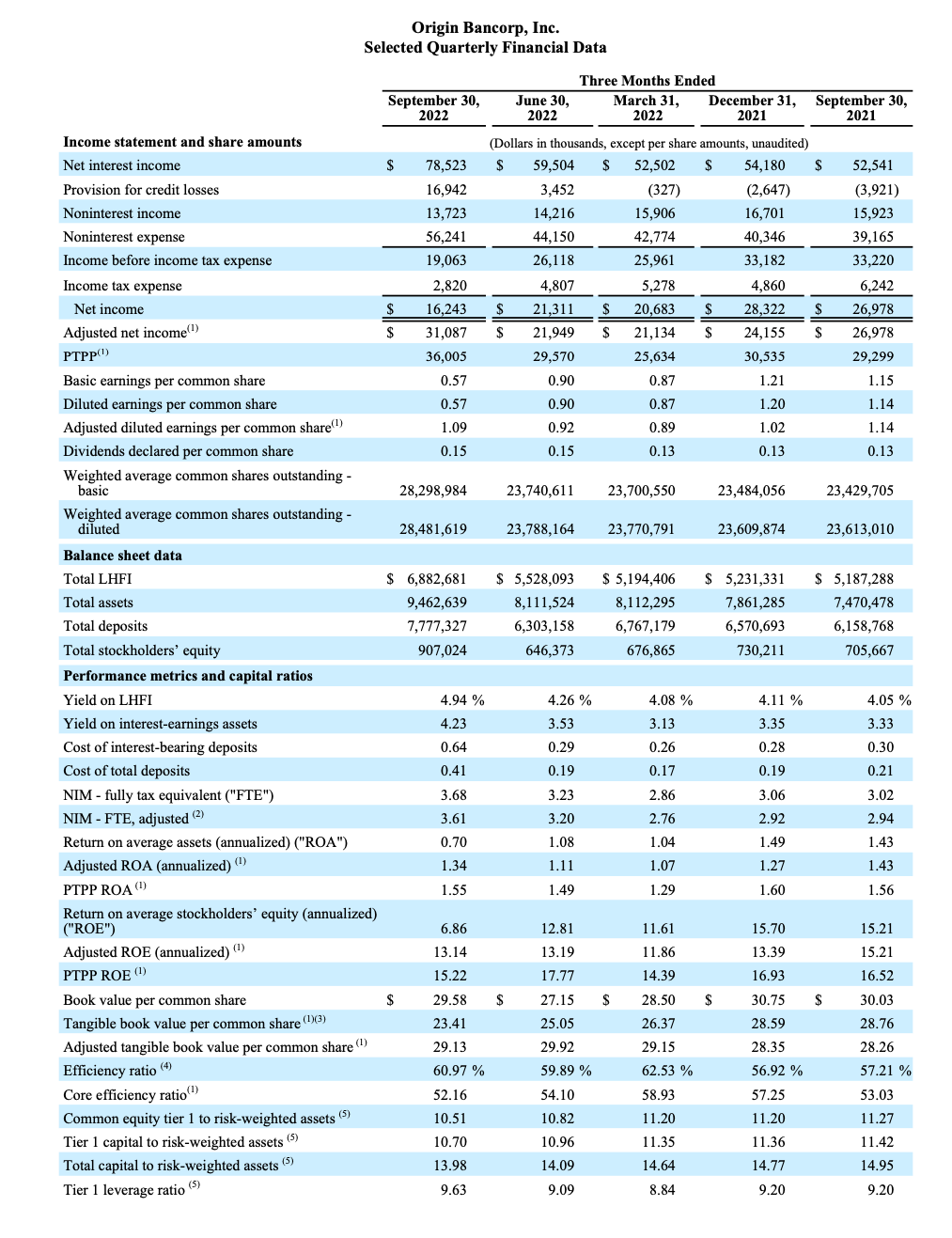
Origin Bancorp, Inc.
Selected Quarterly Financial Data
Adjusted net income, PTPP earnings, adjusted diluted earnings per common share, adjusted ROA, PTPP ROA, adjusted ROE, PTPP ROE, tangible book value per common share, adjusted tangible book value per common share and core efficiency ratio are either non-GAAP financial measures or use a non- GAAP contributor in the formula. For a reconciliation of these alternative financial measures to their comparable GAAP measures, please see the last few pages of this release.
NIM - FTE, adjusted, is a non-GAAP financial measure, and is calculated for the quarter ended September 30, 2022, by removing the net Purchase Accounting ("PAA") accretion from the net interest income. For periods prior to September 30, 2022, it is calculated by removing average PPP loans from average interest-earning assets and removing the associated interest income (net of 35 basis points assumed cost of funds on average PPP loan balances) from net interest income.
A decline in accumulated other comprehensive loss during the YTD period ended September 30, 2022, negatively impacted total stockholders' equity and tangible common equity and caused tangible book value per common share to decline primarily due to the steepening of the short end of the yield curve that occurred during 2022 and its impact on our investment portfolio.
Calculated by dividing noninterest expense by the sum of net interest income plus noninterest income.
September 30, 2022, ratios are estimated and calculated at the Company level, which is subject to the capital adequacy requirements of the Federal Reserve Board.
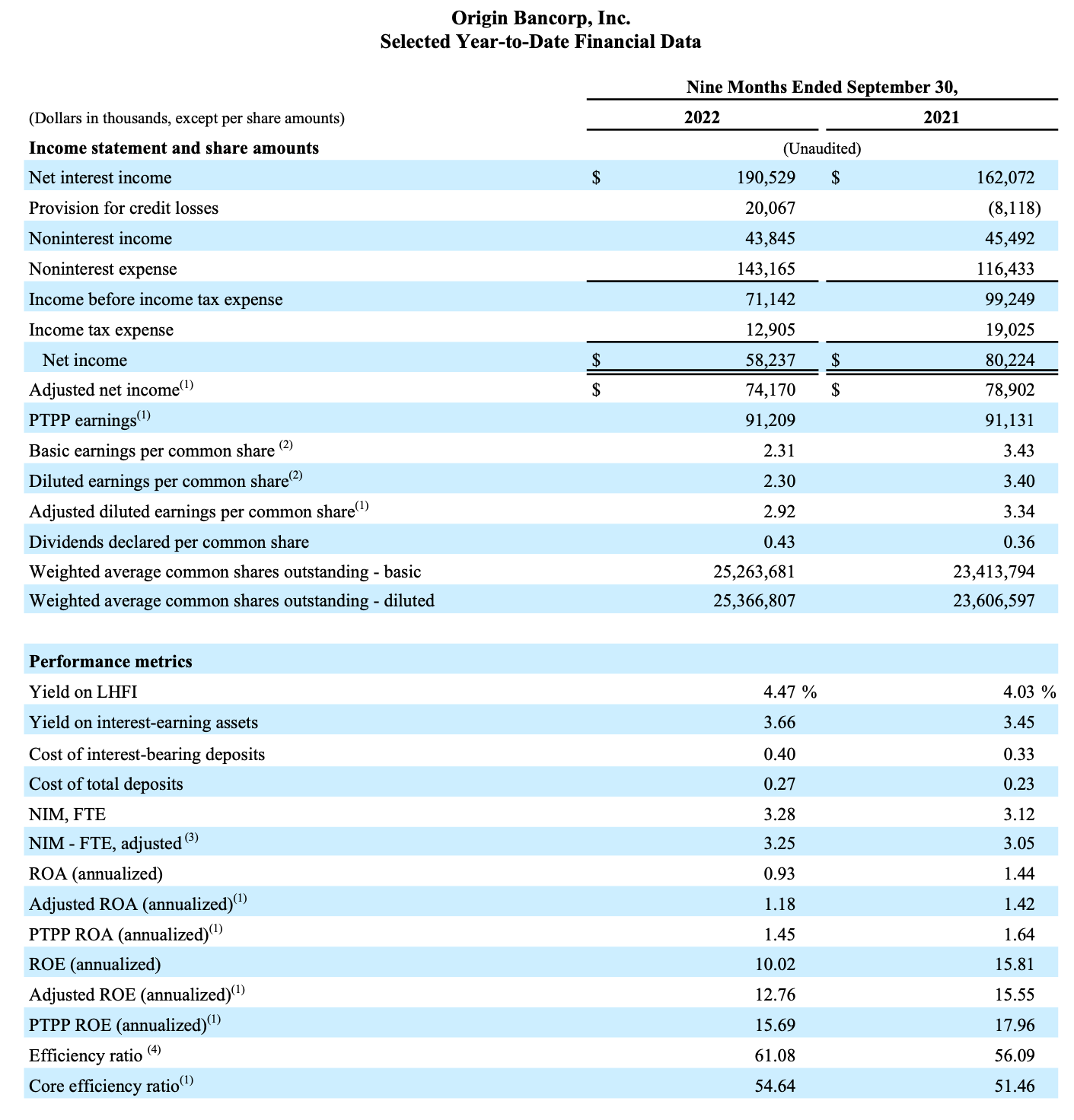
Adjusted net income, PTPP earnings, adjusted diluted earnings per common share, adjusted ROA, PTPP ROA, adjusted ROE, PTPP ROE, and core efficiency ratio are either non-GAAP financial measures or use a non-GAAP contributor in the formula. For a reconciliation of these alternative financial measures to their comparable GAAP measures, please see the last few pages of this release.
Due to the combined impact of the issuance of common stock shares due to the BTH merger on the quarterly average common shares outstanding calculation compared to the impact of the issuance of common stock shares due to the BTH merger on the year-to-date average common outstanding calculation, and the effect of rounding, the sum of the quarterly earnings per common share may not equal the year-to-date earnings per common share amount.
NIM - FTE, adjusted, is a non-GAAP financial measure and is calculated for the nine months ended September 30, 2022, by removing the net PAA accretion from the net interest income. For the nine months ended September 30, 2021, it is calculated by removing average PPP loans from average interest-earning assets and removing the associated interest income (net of 35 basis points assumed cost of funds on average PPP loan balances) from net interest income.
Calculated by dividing noninterest expense by the sum of net interest income plus noninterest income.

